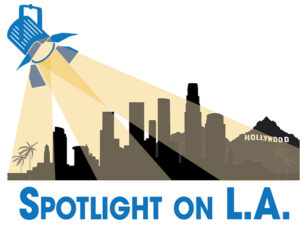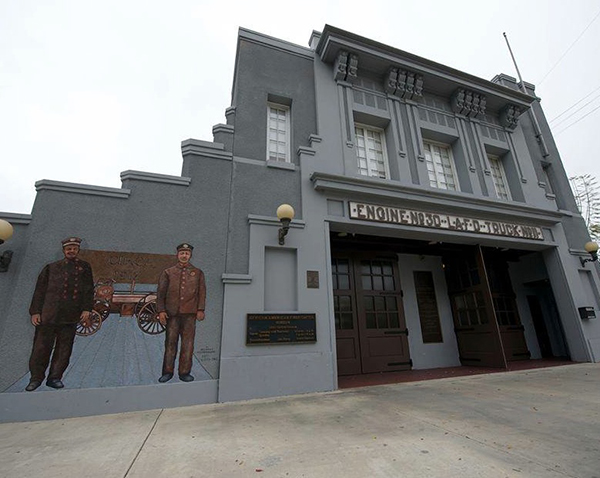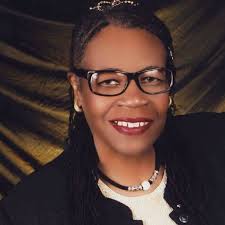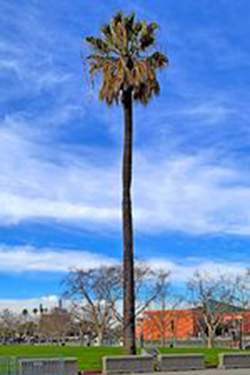By Darlene Donloe
Contributing Writer
The proud history of more than 100 years of service by Black firefighters in Los Angeles is on full display at the African American Firefighters Museum.
The little-known tribute hall, located across the street from the historic Coca-Cola building on South Central Avenue near downtown Los Angeles, pays homage to the brave Black men and women firefighters, some of whom were met with hostility for daring to don the uniform.
The museum is housed at the historic Fire Station No. 30, which was one of two segregated firehouses in Los Angeles between 1924 and 1955. The grounds include the main building, a back building and a memorial sculpture garden in the back.
The space is listed on the National Register of Historic Places and is a cultural heritage landmark in the city of Los Angeles.
Viewing its vintage collection of fire-fighting artifacts is like entering a time tunnel.

The museum opened its doors on Dec. 13, 1997, and is dedicated to collecting, conserving and sharing the heritage of African-American firefighters through collaboration and education.
Michelle Banks, the second Black woman paramedic for the Los Angeles Fire Department, is the organization’s president and co-founder. Other founding members include Los Angeles County Fire Chief Daryl Osby, David Spence, Kwame Cooper, Christopher Cooper, Arnett Hartsfield and Brent Burton.
The dedication of the museum served as the acknowledgment of what was believed to be the city’s first 100 years of service by African American firefighters (1897-1997).
Reportedly in 2002, the Los Angeles Times found evidence that a Black man named Sam Haskins was listed as the first Los Angeles fireman of African descent when he was hired in 1892.
Today, the museum, open to the public, is reportedly, the first and only free-standing African American firefighter museum in the country. The museum’s programming includes tours, disaster preparedness, fire service, recruitment and leadership training.
“History matters,” said Banks in the museum’s video. “Stories of courage and triumph, stories of injustice, struggle and achievement all help to nurture our personal and collective identities.”
Banks said, the preservation and sharing of those stories and the preservation and sharing of places like Fire Station No. 30 “helps to continue to develop a comprehensive, diverse American history as well as create a more civically and vibrant community.”
Brent Burton, an African-American firefighter who is a co-founder of the museum, serves as the museum’s historian, and served as the museum’s president from 2003 to 2014. He believes “everyone should visit the museum.
“Everybody has to go,” he said. “Black people need to learn about their history and celebrate it. Others need to find out what it was like for Black firefighters. They can celebrate, too. Everyone needs to know what we had to overcome.”
The museum’s purpose is to promote diversity and to stand up for inequality against all races and genders.
“When the fire department integrated, Blacks were forced to sleep in the same bed, in the same location, and the other Black firefighter on the other shift, slept in the same bed,” said Burton, a semi-retired, 37-year veteran of the Los Angeles County Fire Department.
He said white firefighters “refused to sleep in the same beds that Black firefighters had slept in.”
“When the Black firefighters were integrated, they couldn’t eat with the white firefighters, and when they did eat, they had to eat by themselves and bring in their own utensils,” Burton said. “They were forced out of the kitchen while the white firefighters ate.”
Burton said white firefighters would contaminate the Black firefighters’ food and even sabotage their safety equipment, which, he said, “is a no, no.”
“They wanted you to cry uncle and go back to Central Avenue,” Burton said. “The Black firefighters said, “no.” They had families to support and a job they wanted and liked.”
Those are just a few of the harrowing stories told through pictures videos, and artifacts at the museum.
“The museum is significant,” said Burton, who has taught at Dorsey High School for 10 years. “We are one of the original museums to highlight and chronicle our pioneering Black firefighters who had to prove themselves in the midst of hostility.”
Burton, who runs a future firefighter program through his nonprofit the Junior Firefighter Youth Foundation, said that while great strides have been made, inequality is still present. He claims that in present-day there is a decrease in the hiring of African Americans in the fire service.
Undeterred, Burton continues his recruiting efforts and visits South Los Angeles schools to talk about firefighting.
His foundation, founded in 2003, is an educational and school-based component of the African American Firefighters Museum.
The purpose of the foundation is to mentor, train and develop young minds for the future.
Burton also tells the story of how African-American firefighters were relocated to Station No. 30 in 1924 because the department, community and school district of Belmont High School became concerned about school children looking at African-American firefighters in positions of authority.
Unfortunately, as the story goes, when the stations became integrated in 1955, firefighters from Station No. 30 and No. 14 were transferred to other stations and met with extreme hostility.
That same year, a Black firefighter association called the Stentorians was formed.
“They are the vanguard of Black firefighters,” said Burton, the president of the Stentorians of Los Angeles County from 2000 to 2010. “They formed back then to fight the department on its segregation policies.”
Before he died in 2014, 96-year-old retired firefighter (1940s and 50s) Arnett Hartsfield, led the integration of the Los Angeles Fire Department. Hartsfield and some of his fellow Black firefighters were Stentorians who, along with the NAACP and the local community, were instrumental in successfully integrating the department.
“We use the story of the old Stentorians to show how individual and collective action can advance society,” said Banks in the museum’s video.
On display in the museum is a plaque that reads, “Colored Served in Rear.”
The first floor of the museum contains vintage fire department apparatus, a fire hose cart, a fire pole, newspaper stories and pictures of pioneering African American firefighters in Los Angeles.
The museum also houses uniforms, helmets and badges from the turn of the century, information on women firefighters and the story of Chicago’s Black firefighters who invented the pole firefighters currently slide down.
There is a gallery on the second floor chock full of pictures, artifacts and other memorabilia of African American firefighters from around the country, including a tribute to the firefighters that perished during the 9/11 attack on the World Trade Center in New York City and information on d’Lisa Davies, the first Black female firefighter in Los Angeles, who retired at the rank of captain.
“The museum chronicles what these Black firefighters endured,” said Burton, who joined the L.A. County Fire Department at age 19 and spent the last 21 years of his career as a firefighter in Inglewood. “We tell the story. We celebrate these achievements and accomplishments. We celebrate the diversity we see today with the fire service. There is a lot to see here and a lot to learn.”
Burton, who runs the mentor program for 100 Black men of Los Angeles where he mentors boys between 11 and 17, said the legacy left by African-American firefighters is one of “perseverance and heroism.”
“We’ve been through so much,” he said.
The African American Firefighter Museum is available for use by organizations and individuals that desire to host events, including meetings, book signings, dances, receptions, retreats, film viewings, jazz festivals, luncheons, dinners and banquets.
The African American Firefighter Museum, located at 1401 S. Central Ave. in Los Angeles, is currently open to the public Sundays only from 1-4 p.m. or by appointment. Admission is free. Information: (213) 744-1730 or email aaffmuseum@sbcglobal.net.
“Spotlight on L.A.” is a new feature profiling little known places within the city. To propose a location for “Spotlight on L.A.,” send an email to dwanlass@wavepublication.com.
Darlene Donloe is a freelance reporter for Wave Newspapers who covers South Los Angeles. She can be reached at ddonloe@gmail.com.












